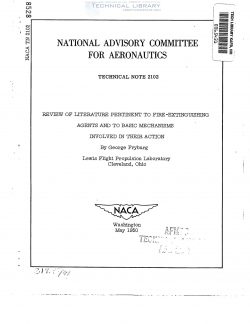naca-tn-2102
- Version
- 110 Downloads
- 3.29 MB File Size
- 1 File Count
- December 9, 2016 Create Date
- December 9, 2016 Last Updated
National Advisory Committee for Aeronautics, Technical Notes - Review of Literature Pertinent to Fire Extinguishing Agents and to Basic Mechanisms Involved in Their Action

Literature relating to fire-extingfiishing agents was reviewed
in order to ascertain ’the extent of present knowledge and to deter-
mine what research might lead to the development of more efficient
agents for extinguishing fires in aircraft.
An analysis of the existing data was made with respect to the
relative extinguishing effectiveness of different substances and
the basic mechanisms involved in the action of extinguishing agents.
Five basic actions of fire-extinguishing agents were enumerated
and discussed. _It appears that mechanical action, blanketing action,
and chain-breaking action are the most important factors in
extinguishing by gaseous and liquid agents.
Recommendations for research were made on the basis of the
analysis. Information on the relative extinguishing effectiveness
indicates that organic halogen compounds will most probably yield
the more powerful extinguishing agents.
The problem of reducing the fire hazard in aircraft is of
paramount importance. If this hazard is to be minimized, maximum
effectiveness in‘fire extinguishing must be achieved. Research
and development in this field have been sponsored and conducted by
the Civil Aeronautics Administration, the Air Force, the Bureau of
Aeronautics, Department of the Navy, and other government and
private laboratories. Although these investigations have been
extensive, the majority have been predominantly applied rather than
fundamental. Emphasis has been placed on such factors as methods
of application of extinguishing agents, optimum rates of appli-
cation, and mian effective quantities required. A preliminary
survey of the aircraft-fire'problem by the HACA Lewis laboratory
staff (reference 1) indicates that a better understanding of the
basic actions of fire-extinguishing agents is still needed.
It is generally assumed that the effect of fire-extinguishing
agents can be explained on the basis of the following actions:
1. Cooling action, which lowers the temperature of the com-
bustible below its ignition temperature
2. Blanketing action, which prevents air from reaching the
fire and results in a dilution of the oxygen content of
the surroundings '
5. Mechanical action, which results from directing the agent
across the fire with sufficient force to cut the flame
away from the combustible
Studies in the recently developed field of chemical kinetics,
however, indicate that certain. substances are capable of exerting
an inhibiting effect on the combustion reactions. This chemical
action is not completely understood and has not yet been extensively
utilized in the search for better fire-extinguishing agents.
| File | Action |
|---|---|
| naca-tn-2102 Review of Literature Pertinent to Fire Extinguishing Agents and to Basic Mechanisms Involved in Their Action.pdf | Download |

Comment On This Post